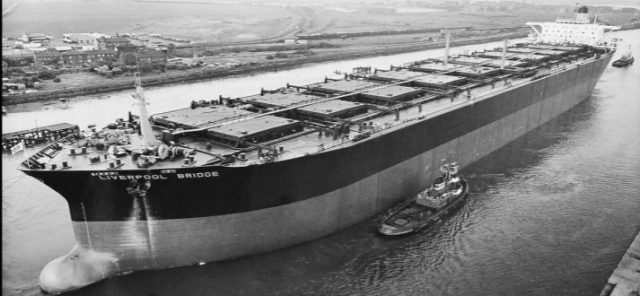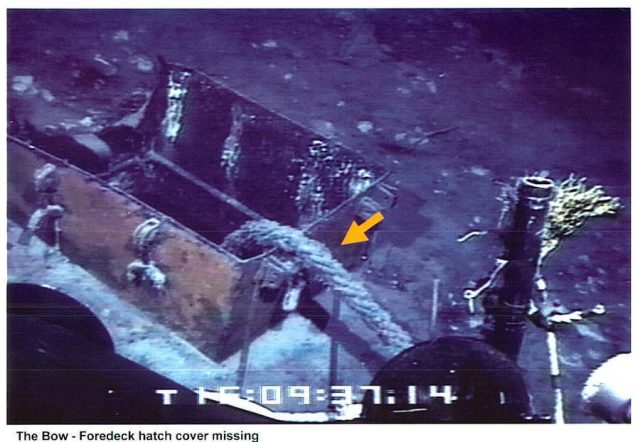Derbyshire

On September 10, 1980 the 294 meter long, 169,044 dwt bulk carrier Derbyshire foundered with all hands during Typhoon Orchid some 230 miles off Okinawa, Japan. The Derbyshire had departed July 11 from Sept-Îles, Canada with 157,446 tonnes of iron ore bound for Kawasaki, Japan. When the Derbyshire failed to arrive in Kawasaki on September 15, a search began for the bulk carrier. By September 20th, the search and rescue operation was called off. Patrol boats and aircraft found only an oil slick and no signs of the 42 crew and 2 wives on board the vessel. There was no distress signal and no indication that the 4 year old vessel would come to a sudden and tragic ending.
https://youtu.be/GHH25IJ20Bc
What was the cause of the sinking?
Having been launched in 1976, the double hulled Derbyshire measured some 965 feet long and 145 feet wide. Manned by an experienced crew, the vessel was classed as A1 by Lloyds Register and quite capable to withstand the strongest storms. Even when faced by a typhoon with 85 knot winds and 20 meter waves, her owners were confident the Derbyshire would arrive in Kawasaki. This confidence would be changed to doubt and lead to several theories to why the bulk carrier sank.
Theory: Overwhelmed by Typhoon Orchid
A 1989 government investigation concluded the Derbyshire had been overcome by the worst part of Typhoon Orchid. The theory suggested the vessel had encountered such severity or had been struck by a rogue wave, the bulk carrier lost her hatch covers, flooded and rapidly sank.
Theory: Design Fault
Some 18 months after the Derbyshire sank, the sister ship Tyne Bridge was proceeding in the North Sea in ballast when the crew found a crack in the deck plate just forward of the superstructure known as frame 65. When taken into drydock, the vessel had sustained multiple cracks, a 19-foot crack on the starboard hull and a 11-foot crack on the port side). Evidence continue to point to a structural design flaw due to a misalignment at bulkhead 65. On November 20. 1986, another sister ship, Kowloon Bridge, broke-in-three with one section breaking off at frame 65 after striking a submerged reef off West Cork, Ireland.

Theory: Crew Negligence & Forward Vents
In 1994, the International Transport Workers Federation launched a search for the wreck of the Derbyshire. Led by David Mearns, the search team found the Derbyshire on the ocean floor. Using ROVs to survey the wreck, they found evidence of a rope from the Bosun’s store hatch and that the hatch toggles were not secured. With this evidence, the hatch lid had not been secured which lead to the fore section of the Derbyshire to flood resulting in structural failure.

With the wreck location found, the British Government re-opened an investigation into the sinking in April 2000. Investigators determined the rope and other evidence found in 1994 were nothing more than debris. This absolved the crew from responsibility in the sinking. The investigation discovered there had been significant damage to the forward vents. With the loss of the vents, the investigation concluded the forward spaces flooded causing the vessel to lose trim by the bow. This subjected hatch covers to be submerged and eventually they failed causing the vessel to flood multiple cargo holds until it sank.
Documents / Materials on the Derbyshire:
Public Inquiry into the Derbyshire (2010).
Faulkner, Douglas. An Independent Assessment of the Sinking of the MV Derbyshire. 1998.
Ship Structure Committee. Derbyshire: Loss of a Bulk Carrier.